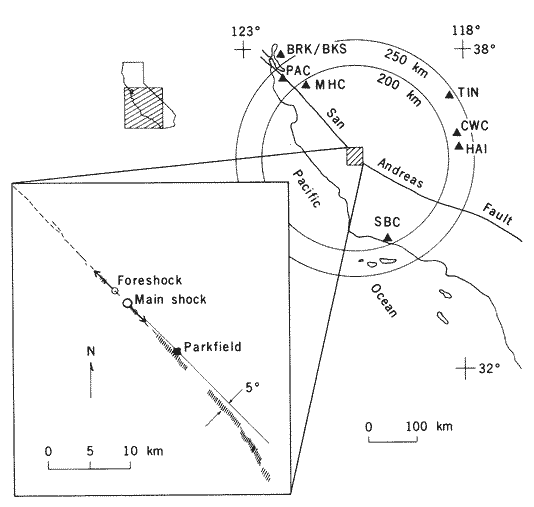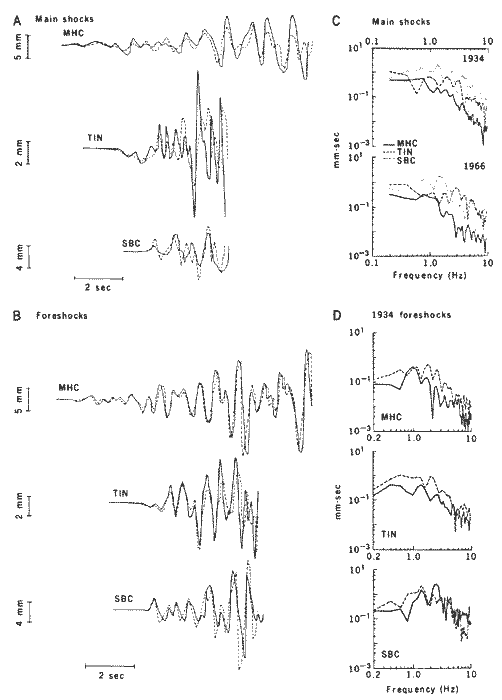

SCIENCE
28 September 1979, Volume 205, pp. 1375-1377.
W.H. Bakun and T.V. McEvilly
Abstract: Moderate-sized earthquakes (Richter scale ML 5 1/2) have occurred four times in this century (1901, 1922, 1934, and 1966) on the San Andreas fault near Parkfield in central California. In many respects the June 1966 sequence was a remarkably detailed repetition of the June 1934 sequence, suggesting a recurring recognizable pattern of stress and fault zone behavior.
Rupture of the San Andreas fault during the main shocks of the 8 June 1934 earthquake near Parkfield, California, propagated toward the southeast. The main shocks occurred at 0447 Greenwich mean time (G.M.T.); 17 minutes 25 seconds earlier, a foreshock of magnitude ML 5.1 on the Richter scale occurred about 1 km to the northwest of the focus of the main shock. Rupture during the foreshock was toward he northwest. A nearly identical sequence of events occurred at Parkfield on 28 June 1966. The 1934 and 1966 events have been compared to obtain a basis for anticipating the characteristics of future Parkfield earthquakes as well as data needed in modeling fault dynamics. Finding a means for predicting future Parkfield earthquakes is especially significant in light of recent suggestions (1) that the great 1857 earthquake of southern California was preceded by foreshocks near Parkfield and that its epicenter may also have been located there.
We have examined Wood-Anderson (W-A) seismograms written at epicentral distances of 180 to 260 km (Fig. 1). Seismograms at stations BRK/BKS, MHC, TIN, and SCB (2) recorded both the 1934 and 1966 Parkfield sequences. Differences in travel times to these stations limit the permissible range of epicenter locations for the 1934 and 1966 Parkfield main shocks and foreshocks to at most 6 km along the fault (3-5). waveform similarities suggest even closer spacing.

As shown in Fig. 2, the seismograms are remarkably similar for the two main shock. For example, the similarity of ground motion at MHC persists for 10 second. The correlation between wave forms from corresponding events implies a common source location and a common initial source-displacement time history. The main shock and foreshock motions, however, are not well correlated with each other at a particular station. The epicenter of the 1966 main shock is accurately located immediately to the southeast of a 5° change in the strike of the trace of the San Andreas fault (6). The ML 5.1 foreshock in 1966 is located 1 to 2 km to the northwest of and at a shallower depth than the 1966 main shock (5, 7). The identical character of the initial seconds of the wave forms foreshocks at a particular station thus implies a common hypocenter location for the 1934 and 1966 foreshocks, a short distance (~1 to 2 km) to the northwest of the common epicenter of the two main shocks. The foreshocks preceded their main shocks by 17 minutes 25 seconds and 17 minutes 17 seconds, respectively, in 1934 and 1966. Although the sizes of the main shocks are comparable (ML ~ 51/2), the seismic-wave amplitude radiation for the 1934 main shocks varied with azimuth: ML= 6 was assigned by CIT (8), using southern California stations, whereas ML=5.2 using the UCB stations to the northwest.

Fourier amplitude spectra of the first 3 seconds of the mainshocks signals in Fig.2A are shown in fig. 2C. first arrivals are Pn compressional waves refracted along the upper mantle at about 7.8 km/sec, followed 5 to 10 seconds later by the Pg crustal phase at 6 km/sec. the low amplitudes of the P waves at MHC are expected theoretically, as this station lies near a node of P-wave radiation for Parkfield earthquakes (9). Relatively higher frequencies are seen at SBC to the southeast than at MHC to the northwest. This azimuthal dependence of frequency content suggests that rupture during the main shocks was directed toward the SBC and away from the MHC (10). Although additional seismic data for the 1934 sequence are sparse, there is independent evidence for unilateral rupture propagation to the southeast along the fault trace for both the 1934 and 1966 Parkfield main shocks (4, 9, 11-13).
By virtue of the sorter rupture lengths of the smaller foreshocks, spectral evidence for their directivity lie at higher frequencies (short wave lengths) than that for main shocks (14). Lateral variations in crustal and upper mantle structure in California produce propagation-path effects that increasingly affect higher frequencies, effectively masking evidence for source differences at distance stations. However, station-by-station comparisons of the foreshocks spectra with those of five reference events suggest that the foreshocks ruptured toward the northwest. Figure 2D compares Pn spectra for the 8 June 1934 foreshock and an earlier 1934 foreshock of ML 5.0 that occurred nearby on 5 June at 2184 GMT (4). Spectra are similar in shape at TIN, which is broadside to the fault to the northeast, an azimuth not sensitive to differences in directivity along the fault trace. However, the high-frequency portions of the spectra are dominant in opposite directions along faults for the two events, indicating that the 5 June foreshock ruptured to the southeast while the later foreshock ruptured northwestward. The spectral differences illustrated in Fig. 2D are typical of the subtle, but clear seismological evidence for differences in directivity of Parkfield earthquakes.
The similarities in fault behavior in the 1934 and 1966 sequences suggest a scenario for Parkfield earthquakes. An ML 5.0 earthquake (the foreshock) occurs immediately northwest of the bend in the fault (the 5� change in the strike of the fault trace), which acts as a barrier to slip. The fault zone near the hypocenter of the main shock, southeast of the bend, is loaded by slip associated with the foreshock, even though that slip need not extend through the bend to the vicinity of the main shock hypocenter. The main shock does not occur immediately, but the loading is sufficient to initial the inevitable failure of the fault zone southeast of the bend. The main shock occurs about 17 minutes later immediately northeast of the bend, which again acts as a barrier to slip, directing rupture growth toward the southeast. Note that breaking of the bend itself during the sequence is not necessary even though the loading stress is transmitted across it. The extent of rupture during the main shock may be controlled by physical discontinuities on the flat surface (6, 15). Great earthquakes on the San Andreas fault, such as that in 1857, would thus initially resemble moderate-sized events and grow to full extent by breaking the barriers that arrest slip in the ML 51/2 shocks. It may well be, then , that successful prediction of major earthquakes (that is, smaller ruptures that have "gotten away") will involves an assessment of the potential for rupture growth across barriers.
Although the initial stages of the 1934 and 1966 Parkfield sequences were similar, the 1934 sequence included an early ML5.0 foreshock (the reference event in Fig. 2D), whereas the 1966 sequence did not (4, 9). Improved instrumental coverage in 1966 revealed southeastward migration of small earthquakes in the months preceding the mains shock toward its epicenter (9), while fresh cracks on the fault southeast of Parkfield 2 weeks before the 1966 main shock (16) are consistent with substantial precursory aseismic slip on the fault. The migration of small shocks or precursory aseismic slip, or both, could serve as the 1966 loading counterpart to the early 1934 foreshock. The sparse instrumental data available for the 1922 Parkfield earthquake and the similar descriptions for the 1901 Parkfield shock strongly suggest that they occurred near and were comparable in size to the 1934 and 1966 main shocks; neither was preceded by felt foreshocks (17), so that the 1901 and 1922 Parkfield shocks so not conform precisely to to the proposed scenarios. However, the failure patterns in 1934 and 1966 suggest that future ML 51/2 earthquakes at Parkfield will follow episodes of stress concentration at the bench in the fault trace.
W.H. Bakun, U.S. Geological Survey, Menlo Park, CA 94025
TV McEvilly, Seismographic Station, Department of Geology and Geophysics, University of California, Berkeley 94720
| 1. | K.E. Sieh, Bulletin of the Seismological Society of America. 68, 1731 (1978). |
| 2. | Berkeley (BRK/BKS), Palo Alto (PAC), and Mount Hamilton (MHC) are operated by the seismographic Stations of he University of California, Berkeley (UCB). Tinemaha (TIN), Haiwee (HAI), Cottonwood (CWC), and Santabarbara (SBC) are stations operated by the Seismological Laboratory, California Institute of Technology (CIT). |
| 3. | P. Byerly and J.T. Wilson, Bulletin of the Seismological Society of America. 25, 223 (1993). |
| 4. | J.T. Wilson, Bulletin of the Seismological Society of America. 26, 189 (1936). |
| 5. | Assuming a Pn velocity of 8.0 km/sec and constraining the epicenters to the fault trace, an increase of 1 second in the difference between the first arrival times at MHC and SBC,Dt(MHC - SCB), requires a 4-km shift to the southeast in epicenter location. The DT(MHC - SCB) values are 6.0±1, 1.5±1, -0.3±0.1 and 0.0±0.1 second, respectively, for the 8 June 1934 foreshock (0430 G.M.T.), the 8 June 1934 main shock (0447 G.M.T.), the 28 June 1966 foreshock (0408 G.M.T.), and the 28 June 1966 main shcoks (0426 G.M.T.). |
| 6. | A. Lindh and D.M. Boore, Earthquake Notes 45, 54 (1974). |
| 7. | W.H. Bakun, Journal of Geophysical Research. 77, 3816 (1972). |
| 8. | J.A. hileman, C.R. Allen, J.M. Nordquist, Seismological Laboratory California Institutie of Techonology Contributions 2385 (1973). |
| 9. | T.V. McEvilly, W.H. BakunK.B. Cassaday, Bulletin of the Seismological Society of America. 57, 1221 (1967). |
| 10. | A. Ben-Menahem, Journal of Geophysical Research. 67, 345 (1962). |
| 11. | R. Brown and J. Vedder, U.S. Geological Survey Professional Paper 579 (1967), p.2. |
| 12. | J.P. Eaton. U.S. Geological Survey Professional Paper 579 (1967), p.57; J. Filson and T.V. McEvilly, Bulletin of the Seismological Society of America. 57, 1245 (1967). |
| 13. | K. Aki. Journal of Geophysical Research. 73, 5359 (1968). |
| 14. | J.C. Savage. Journal of Geophysical Research. 77, 3788 (1972). |
| 15. | S. Das and K. Aki. Journal of Geophysical Research. 82, 5658 (1977). |
| 16. | C.R. Allen and S. W. Smith, Bulletin of the Seismological Society of America. 56, 966(1966) |
| 17. | K. E. Sieh, personal communication. |
| 18. | The siesmograms were digitized from enlargements of the original north-south component W-A records. We removed minute marks, differences in recorder drum rotation rates,trace skew, and so on. Time axes were arbitrarily adjusted for maximum visual correlation. |
| 19. | A cosine taper was applied to the final 5 percent (0.15 seconds) of the first seismic phase before computing the Fourier spectrum. |
| 20. | We thank A. Lindh and W. Stuart for suggestions and B. Raleign and R. Archuleta for critical reading of the manuscript. |
13 March 1979